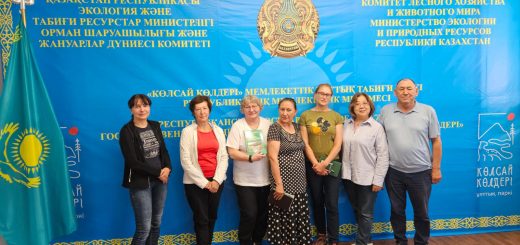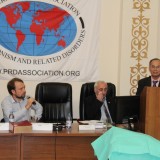Purple day (Epilepsy awareness day)
On March 26, the world observes Purple Day, an annual international event aimed at raising awareness about epilepsy.
Epilepsy is a chronic brain disorder characterized by recurrent, mostly unprovoked seizures that affect motor, sensory, autonomic, cognitive, or mental functions. These seizures occur due to excessive neuronal discharges in the cerebral cortex.
According to the World Health Organization (WHO), epilepsy affects up to 1% of the world’s population, which is approximately 50 million people. However, only 25% of them receive adequate medical treatment. It is crucial to know that modern medications can completely prevent seizures in 70% of cases. These drugs are effective, low in toxicity, and do not affect a person’s psyche or mood.
The initiative was started by a nine-year-old girl, Cassidy Megan, who has epilepsy. At a young age, she experienced stigma and misunderstanding from both adults and peers, who often viewed her condition incorrectly, sometimes even as a mild form of insanity.
To break the myths surrounding epilepsy, Cassidy created Purple Day in 2008. On this day, March 26, people around the world can show their support for those living with epilepsy. Her initiative was first supported by the Epilepsy Association of Nova Scotia and later by other organizations worldwide. By 2009, 100,000 students, about 100 public organizations, and over 100 well-known politicians had joined the movement. That same year, Toronto’s iconic CN Tower was lit up in purple for the evening.
Since then, March 26 has been dedicated to spreading information about epilepsy and educating people on first aid for seizures in many countries worldwide.
Lavender – the international color of epilepsy.
The color purple (or lavender) was chosen as the symbol of Purple Day for a reason. It is believed to have a calming effect on the nervous system, reducing anxiety, phobias, and fears. That’s why, on March 26, participants and supporters wear purple ribbons or clothing to express their solidarity with people living with epilepsy.
Epilepsy is one of the few chronic diseases where long-term remission is possible. People with epilepsy can study, work, build families, and have healthy children, leading normal and fulfilling lives.
Many historical figures are believed to have had epilepsy, including Julius Caesar, Alexander the Great, Nostradamus, Dante Alighieri, Ivan the Terrible, Napoleon Bonaparte, Fyodor Dostoevsky, Alfred Nobel, and Vincent van Gogh. In ancient Greece and Rome, epilepsy was referred to as “divine intervention,” “Hercules’ disease,” and “the royal disease.”
The Socioeconomic Impact of Epilepsy
Epilepsy has significant economic consequences in terms of healthcare needs, premature mortality, and lost productivity. Nearly 80% of people with epilepsy live in low- and middle-income countries.
In Kazakhstan, there are over 45,000 people diagnosed with epilepsy, with about 40% of them being children. Globally, children are the most affected group, as statistics indicate that three-quarters of all epilepsy patients are under the age of 18. Unfortunately, obtaining accurate epidemiological data on epilepsy in Kazakhstan is challenging due to the lack of a unified registry system, differences in classification criteria among specialists, and the frequent misdiagnosis of epilepsy under other conditions, such as seizure syndromes. There is a growing need to conduct epidemiological studies using standardized criteria and to establish a national epilepsy registry. Such studies will help assess the prevalence and incidence of epilepsy, improve diagnostic accuracy, enhance medical care, and regulate the provision of antiepileptic medications.
Healthcare Support for Epilepsy Patients in Kazakhstan
The Ministry of Health of the Republic of Kazakhstan pays close attention to epilepsy patients. In 2022, the list of medications available for epilepsy treatment was expanded. A ministerial order added new antiepileptic drugs for children, including Tetracosactide, Ethosuximide, Vigabatrin, Sultiame, Lacosamide, Perampanel, Phenytoin, Zonisamide, Stiripentol, and Clobazam.
For adult patients, a wide range of anticonvulsants is also available, including Carbamazepine, Valproic Acid, Oxcarbazepine, Lamotrigine, Topiramate, and Levetiracetam.
Kazakhstan has established the Kazakh National League Against Epilepsy, whose primary goal is to create a professional platform for discussing current issues in epileptology, ensuring continuous professional development for specialists, and advancing epilepsy care in line with international standards.
The Need for Scientific Research and Specialized Epilepsy Centers
There is an urgent need for scientific research in this field and the establishment of epilepsy centers in major regions of Kazakhstan. These centers should be equipped with modern diagnostic tools, including EEG monitoring, facilities for dynamic monitoring of antiepileptic drug levels in blood plasma, and other advanced technologies.
WHO pilot projects have demonstrated that specialized training for primary healthcare providers in diagnosing and treating epilepsy can significantly reduce the treatment gap. However, the shortage of trained healthcare professionals remains a major challenge in providing adequate care for epilepsy patients.
Currently, efforts are being focused on improving the qualifications of neurologists and primary healthcare workers in epilepsy diagnosis, treatment, and long-term patient management.
Head of the Department of Neurology, Asfendiyarov Kazakh National Medical University,
Chief Neurologist of the Ministry of Health of the Republic of Kazakhstan T. Turuspekova










